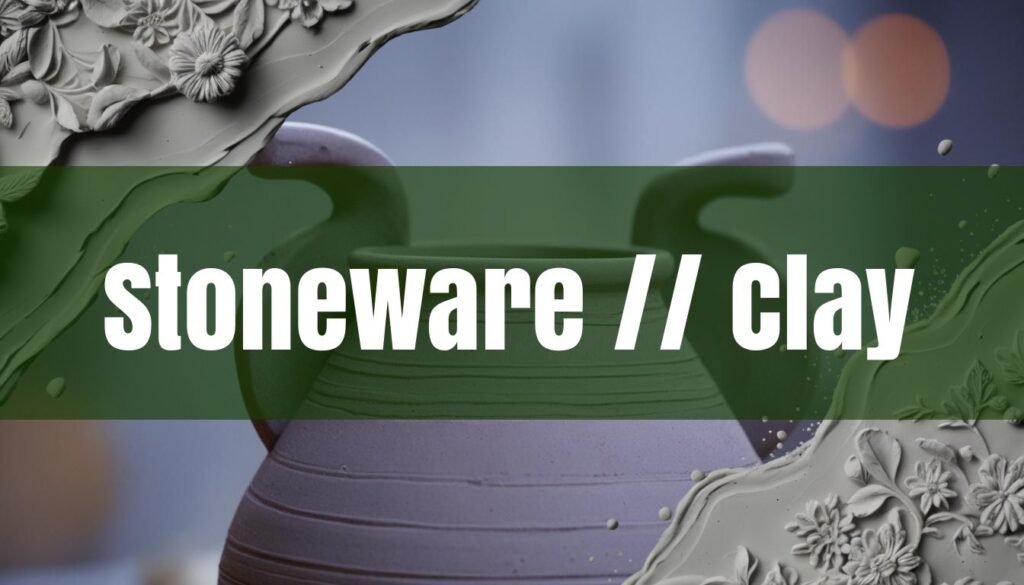Purchasing stoneware clay online has become increasingly popular among potters due to its convenience and accessibility. However, navigating the online marketplace requires careful consideration to ensure you’re getting the right clay for your needs, that it arrives in good condition, and that you know how to store it properly. Several online retailers and suppliers offer a wide selection of stoneware clays, each with its own advantages and disadvantages. When choosing where to buy your stoneware clay, it’s important to balance factors such as clay body availability, shipping costs, customer reviews, and the specific requirements of your pottery projects.
Where to Buy Stoneware Clay Online
When deciding where to buy stoneware clay, consider the variety of clay bodies offered. Different projects require different types of clay, so a supplier with a wide selection can be advantageous. For example, if you plan on creating functional ware like bowls or mugs, you’ll need a clay that can withstand the thermal shock of heating and cooling. Cone 5 stonewares are often recommended for their resistance to thermal shock, but all ovenware made of stoneware should be heated and cooled gradually. Some popular online retailers include The Ceramic Shop, Sheffield Pottery, and Bailey Pottery. These suppliers offer a range of stoneware clays suitable for various pottery techniques, including throwing, hand-building, and sculpting. High fire white stoneware clays, for example, are popular for their clean canvas, which allows for a myriad of glaze colors. Earthen-colored stoneware clays produce durable ware and react favorably to reduction firing, performing well in both wheel throwing and hand-building methods. For sculpting large projects, look for sculpture clay bodies that contain significant amounts of sand and grog, which reduce shrinkage. You may also find that understanding the different types of clay is beneficial.
Buying Clay Online vs. In Person
Buying clay online offers convenience, but it also has its drawbacks compared to buying in person. One of the most significant advantages of buying in person is the ability to physically inspect the clay before purchasing it. You can assess its moisture content, workability, and consistency, ensuring it meets your specific needs. When buying online, you rely on the supplier’s description and customer reviews, which may not always provide a complete picture. However, online retailers often offer a wider selection of clay bodies than local suppliers, allowing you to experiment with different types and find the perfect clay for your projects. Additionally, online stores are generally open 24/7, which adds to the convenience.
One of the primary concerns when buying clay online is shipping costs. Clay is heavy, and shipping can be expensive, especially for large quantities. Some suppliers offer free shipping on orders over a certain amount, so it’s worth checking for these deals. Also, consider the supplier’s location relative to yours. The closer the supplier, the lower the shipping costs will likely be. It’s also essential to consider the time it will take for the clay to arrive. If you need the clay urgently, choose a supplier with fast shipping options. When your clay arrives, carefully inspect the packaging for any signs of damage. If the packaging is damaged, take photos and contact the supplier immediately. Open the package and check the clay for any signs of drying out or contamination. If the clay is not in good condition, contact the supplier to request a replacement or refund. It is also important to understand proper clay storage and care.
Tools and Equipment for Working with Stoneware Clay
Once you’ve acquired your stoneware clay, having the right tools and equipment is essential for successful pottery making. The tools range from basic to advanced, and choosing the right ones can greatly enhance your creative process. Basic tools include aprons, a banding wheel, bats, brushes, and sponges. Aprons protect your clothing from clay and water, while banding wheels provide a rotating platform for building and decorating your pieces. Bats are used to support your work on the pottery wheel, and various brushes and sponges help in applying water, slips, and glazes. For shaping clay, ribs are essential for removing unevenness and compressing the surface of your piece. Wire cutters are used for slicing clay from the bag and cutting pots off the wheel, while needle tools are useful for cutting, piercing, and measuring depth. Scoring tools are used for scratching the surface of the clay to join two pieces together.
More advanced tools include trimming tools, which are designed for clean and accurate cuts, and carving tools, which allow you to add intricate designs and textures to your ceramics. Rolling pins are great for making small slabs for hand-building, while paddles are useful for altering leather-hard forms or creating even walls and shaping larger forms. Stamps and texture rollers can add accent patterns or designs to your pottery, and applicator bottles are great for decorating with precise control when using slips and glazes. For measuring fitted lids, calipers are ideal, and decorating disks help divide the piece evenly to ensure seamless decoration. Investing in quality tools made from durable materials ensures long-lasting performance and reliable results, enhancing your ability to create, shape, and perfect your ceramic projects with ease and precision.
Glazing and Firing Stoneware
Once your stoneware piece is formed and bisque-fired, glazing is the next crucial step to enhance its appearance and functionality. Pottery glaze adds unique colors and textures to your pieces. Various glazing techniques can be employed, each offering distinct visual effects. Dipping is one of the easiest methods to cover pottery, providing a smooth and fine texture. Pouring involves flowing the glaze over the piece, allowing it to absorb and create an even layer. Brushing can be used as both a base layer and for decorating, with large flat brushes suitable for larger pieces and small, round-tip brushes better for intricate patterns. Spraying, which requires an air gun or spray gun and a banding wheel, is ideal for laying down a precise base layer.
Other techniques include splattering, which involves flicking glaze onto the piece for a more abstract texture, and stippling, which is used when shadow effects are needed or to give the glaze a painted look. Sponging is another method for adding texture, with different sponge types creating various patterns. Glaze trailing involves drawing glaze-on-glaze or glaze-on-clay designs using a slip trailer, and the wax resist technique repels glazes and underglazes, allowing for intricate patterns. Layering different glazes can create unique colors and finishes, often mixing brands and glaze finishes to achieve the desired effect. To emulate the effects of reduction firing in an electric kiln, slow the temperature gain during the last several hours of firing, soak the kiln at the top temperature, and then down-fire to slow the cooling cycle.
Firing schedules for stoneware clay vary depending on the type of kiln used. Stoneware is typically fired between Cone 2 and Cone 12, with Cone 6 and 10 being the most common for mid-range and high fire stoneware, respectively. Electric kilns, which allow oxygen into the firing chamber, create an oxidation firing, while fuel-burning kilns can create a kiln atmosphere without oxygen, known as a reduction firing. The kiln firing schedule refers to the speed, time, and temperatures to which kilns are heated to complete the ideal firing conditions for the pots inside. A typical stoneware glaze firing schedule involves heating at 80°C per hour up to 200°C, then 120°C per hour up to 1260°C, with a 15-minute soak at 1260°C. It’s important to understand the recommended firing temperature and timing for your chosen glaze to ensure optimal results. For more information, consider reading about firing temperatures for pottery.
Troubleshooting Common Stoneware Problems
Working with stoneware can sometimes present challenges, but understanding common problems and how to troubleshoot them can help you achieve successful results. Cracking is a common issue that can occur during the drying, bisque firing, or glaze firing stages. It can be caused by the clay drying too quickly, uneven support, overworking the clay, extreme temperature changes, improper wedging, or too much moisture. To prevent cracking, allow the clay to dry slowly and evenly, provide proper support, avoid overworking the clay, and ensure the clay is properly wedged. Warping can occur if the clay is not properly supported or if it is not allowed to dry evenly. Ensure adequate support during drying and firing to minimize warping.
Glaze defects are also common and can include pinholes, shivering, crawling, crazing, and dunting. Pinholes are small holes or bubbles in the glaze, often caused by impurities or incomplete coverage. Shivering is the cracking or flaking off of glaze, which can occur if the glaze is not properly matched to the clay body. Crawling is the separation of the glaze into small islands or clumps, often due to a glaze that is too thick or a surface that is not properly cleaned. Crazing is a network of fine cracks on the surface, caused by different coefficients of expansion between the clay body and glaze. Dunting is cracking due to thermal shock during cooling, often caused by a cooling process that is too rapid. To avoid glaze defects, choose glazes that are appropriate for the clay type and firing temperature, apply the glaze evenly and at the appropriate thickness, and ensure the glaze is completely dry before firing. Finally, bloating occurs when clay contains too much moisture and expands during firing. Ensure the piece is completely dry before firing to prevent bloating.





